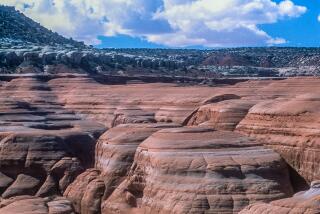Flights Over Grand Canyon
- Share via
I strongly disagree with your editorial (Oct. 29), calling for a ban on scenic flights over the Grand Canyon. There are not “ . . . many ways to enjoy the Grand Canyon . . ., “ as you stated.
--It may be viewed from outlooks on its rim, which give no hint to the scenic majesty of its inner gorge.
--It may be seen from afoot or muleback, which afford a sorely limited view from the few trails that descend its walls.
--It may be viewed from the bottom up, aboard rafts or boats on the Colorado River.
Only the first and last methods are free from strenuous physical exertion. Only the last offers the canyon visitor a true picture of the canyon’s awesome dimensions.
In early September I saw the Grand Canyon from the bottom up. Together with 20 other people I ran its rapids, camped on sand bars and saw the canyon as I have never seen it before. During our seven days and nearly 300 miles on the Colorado we saw more wild sheep than backpackers (only two of the latter.) We also saw, on several occasions, the ungainly looking airplanes employed for scenic flights.
We were amused, rather than offended by them and named them “Low and Slow Airlines.” Yes, they were visible, but they flew high enough to be barely audible and they were out of sight and earshot in just a couple of minutes. Surely, their impact on “ . . . wildlife and park resources like ancient Indian dwelling” was far less than the buzz of the small outboard engines powering our rubber rafts. In effect, nil.
Certainly, there should be some regulation of scenic flights above the Grand Canyon with respect to minimum altitude and routes of flight. However, an outright ban of such flights is wrong.
If The Times is truly concerned with preserving the majestic canyons of the Colorado, I would suggest that it focus its attention on the still-viable proposal to construct a hydroelectric project downstream from the boundary of Grand Canyon National Park.
This dam would drown exciting rapids and enchanting side canyons with dead, slack water right up to the park’s boundary. It would place a generating plant in an area with no demonstrable need for electricity. It would give Indian tribes on the South Rim complete control over all development that would surely follow construction of the dam.
This is a use of the canyons of the Colorado that should be forever banned!
H.W. BAYLES
Torrance
More to Read
Sign up for The Wild
We’ll help you find the best places to hike, bike and run, as well as the perfect silent spots for meditation and yoga.
You may occasionally receive promotional content from the Los Angeles Times.






